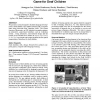Free Online Productivity Tools
i2Speak
i2Symbol
i2OCR
iTex2Img
iWeb2Print
iWeb2Shot
i2Type
iPdf2Split
iPdf2Merge
i2Bopomofo
i2Arabic
i2Style
i2Image
i2PDF
iLatex2Rtf
Sci2ools
CHI
2005
ACM
2005
ACM
A gesture-based american sign language game for deaf children
We present a system designed to facilitate language development in deaf children. The children interact with a computer game using American Sign Language (ASL). The system consists of three parts: an ASL (gesture) recognition engine; an interactive, game-based interface; and an evaluation system. Using interactive, user-centered design and the results of two Wizard-of-Oz studies at Atlanta Area School for the Deaf, we present some unique insights into the spatial organization of interfaces for deaf children. Author Keywords Deaf; children; ASL; design; Wizard-of-Oz method; computer games; computer aided language learning ACM Classification Keywords H.5.2 [Information interfaces and presentation]: User Interface - User-centered Design; K.8.0 [Personal Computing]: Games
ACM Classification Keywords | CHI 2005 | Deaf Children | Human Computer Interaction | User-centered Design |
| Added | 30 Nov 2009 |
| Updated | 30 Nov 2009 |
| Type | Conference |
| Year | 2005 |
| Where | CHI |
| Authors | Seungyon Claire Lee, Valerie L. Henderson, Harley Hamilton, Thad Starner, Helene Brashear, Steven Hamilton |
Comments (0)

